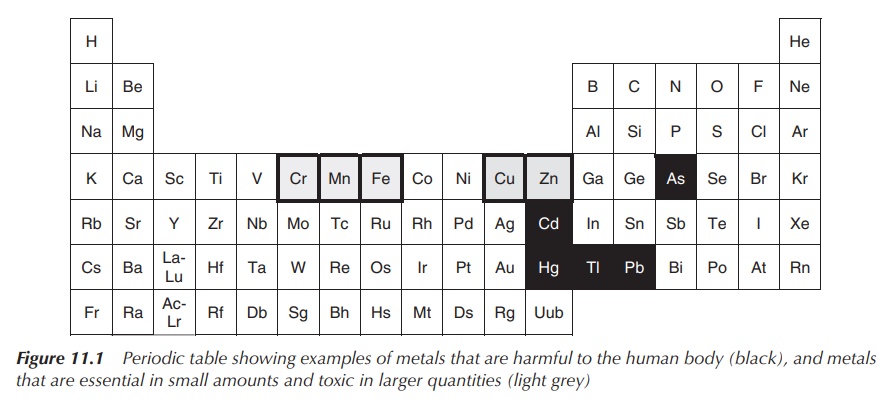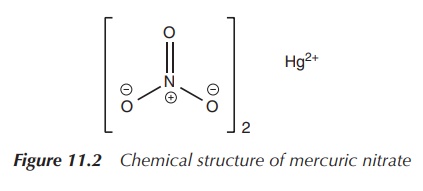What is heavy-metal poisoning?
| Home | | Inorganic Pharmaceutical Chemistry |Chapter: Essentials of Inorganic Chemistry : Chelation Therapy
Heavy-metal poisoning is defined as the accumulation of toxic metal in the body, mainly in the soft tissue. There is an on-going debate on how to define heavy metals.
What
is heavy-metal poisoning?
Heavy-metal poisoning is defined as the accumulation of toxic
metal in the body, mainly in the soft tissue. There is an on-going debate on
how to define heavy metals. Mostly, it is defined as an element that has more
than five times the density of water. With regard to danger to human health,
all metals that cause harm to the body should be included, such as lead,
mercury, arsenic, thallium and cadmium. Some heavy metals, such as zinc,
copper, chromium, iron and manganese, are required by the body in small amounts
but are toxic in larger quantities (see Chapter 7) (Figure 11.1).

Figure 11.1 Periodic table showing examples of metals that are harmful to the human body (black), and metals that are essential in small amounts and toxic in larger quantities (light grey)
Heavy metals can be taken up by ingestion (food or drink),
through air (inhalation) or also by absorption through the skin. Heavy metals
are then mostly stored in the soft tissue. Places of exposure can often be
traced back to the work place (industrial work, pharmaceutical industry or
agriculture). Contaminated sand and soil on playgrounds are known to have been
responsible for heavy-metal poisoning in children. Within the human body, toxic
heavy metals typically compete with essential metals, such as magnesium, zinc,
iron, calcium and others for their receptors. This can lead to irreversible
organ damage.
Depending on the type and quantity of heavy metal absorbed, the
patient will display varying symptoms. These may include vomiting, nausea,
diarrhoea, sweating, headache and a metallic taste in the mouth. In severe
cases, heavy-metal poisoning can lead to impairment of cognitive, motor and
language skills in the patients. The famous expression ‘mad as a hatter’
originated in seventeenth-century France, where hat makers used a toxic mercury
salt (mercuric nitrate) to soak animal hides (Figure 11.2).

Figure 11.2 Chemical structure of mercuric nitrate
Heavy-metal poisoning is diagnosed using blood and urine tests, or by hair, tissue and X-ray analysis. Upper concentration limits in blood depend on the individual metal. Whilst very high concentration levels lead to serious health concerns, it has been shown that, especially in children, even lower levels can lead to chronic health problems. Additionally, the length of exposure can be crucial for developing serious health problems. Exposure to a heavy metal of a long period can be highly toxic even at low levels. Diagnosing the concentration of heavy metal, which rapidly clears from the blood, can be fairly difficult.
Arsenic clears rapidly from the blood stream, and it might be
possible to detect arsenic poisoning in the urine up to ∼48–72 h. Acute arsenic poisoning especially
after ingestion of arsenic may be visualised by using X-ray diagnosis, as
arsenic is opaque to X-rays. Furthermore, arsenic can be detected in hair and
nail for a month following the exposure.
The main treatment option for heavy-metal poisoning is the
so-called chelation therapy. Chelation therapy is based on the principle that
the toxic heavy metal is bound to a chelating agent, which reduces its toxicity
and removes it from the human body.
Related Topics
